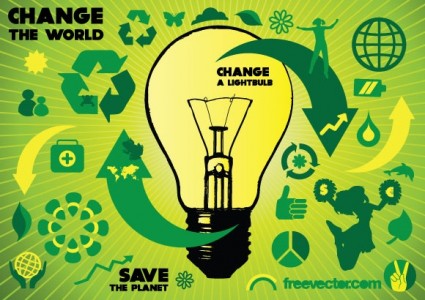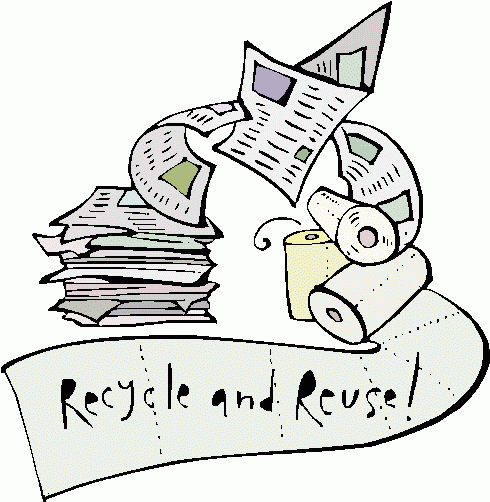Living Green
Living green means the things we use don’t harm us or the environment. One of the advantages of “green living” is that it is generally more economical in the long run. Some energy efficient products cost more initially than their non-efficient alternatives but they save energy and last longer, like compact fluorescent light bulbs. You can start saving the planet with this one tiny step. Every little thing that each of us does to reduce our impact on the planet helps make it a safer, more sustainable place to live. Warning: Once you start going green, you may not be able to stop. You will realize that the little things have a big impact.

Did you know?
 The average American creates over 2000 pounds of garbage every year
If every home in the U.S. replaced just one light bulb with an ENERGY STAR CFL, we would save enough energy to light more than 2.5 million homes for a year and prevent greenhouse gases equivalent to the emissions of nearly 800,000 cars. Switching to compact fluorescent bulbs will save about $50 per year, per bulb.
Programmable thermostats can save you $100 a year on your energy bill.
Move your thermostat down just 2 degrees in winter and up 2 degrees in summer to save about 2,000 pounds of carbon dioxide a year.
Water-saving showerheads use only 2.5 gallons of water (or less) per minute; older showerheads use 5 to 7 gallons per minute.
Install a water-saving showerhead to save 350 pounds of carbon dioxide per year thanks to the energy savings from less heating of water.
Switch to an ultra-low flow toilet, which use only 1.6 gallons of water per flush, to reduce indoor water use by as much as 20%. Older toilets use 3.5 to 7 gallons per flush.
If your faucet is dripping at the rate of one drop per second, that would waste 2,700 gallons per year! That adds to the cost of water and sewer utilities, or needlessly strains your septic system.
Recycle rain water to reduce your personal energy consumption by using less treated water. Use a rain barrel to hold back up to 6% of the rainwater falling on your property. This helps reduce flooding and pollution in the storm water system.
Avoid 10 miles of driving every week to eliminate about 500 pounds of carbon dioxide emissions a year.
Share a ride with someone at least two days a week. You'll reduce your carbon dioxide emissions by 1,590 pounds a year.
Before you buy your next car, consider car sharing. Community car-sharing organizations provide access to a car and your membership fee covers gas, maintenance and insurance.
Talk to your boss about telecommuting, to reduce the number of miles you drive every week.
The average American dinner travels 1,500 miles before reaching the dinner plate. Eating local food greatly reduces the consumption of fossil fuels and wasteful packing materials.
Buying locally keeps money in your community.
Local farmers’ markets reduce the amount of energy required to grow and transport the food to you by one fifth.
It’s important to buy organic as much as possible. Organic soils capture and store carbon dioxide at much higher levels than soils from conventional farms.
If we grew all of our corn and soybeans organically, we’d remove 580 billion pounds of carbon dioxide from the atmosphere.
Methane is the second most significant greenhouse gas and cows are one of the greatest methane emitters. Their grassy diet and multiple stomachs cause them to produce methane, which they exhale with every breath.
The average American creates over 2000 pounds of garbage every year
If every home in the U.S. replaced just one light bulb with an ENERGY STAR CFL, we would save enough energy to light more than 2.5 million homes for a year and prevent greenhouse gases equivalent to the emissions of nearly 800,000 cars. Switching to compact fluorescent bulbs will save about $50 per year, per bulb.
Programmable thermostats can save you $100 a year on your energy bill.
Move your thermostat down just 2 degrees in winter and up 2 degrees in summer to save about 2,000 pounds of carbon dioxide a year.
Water-saving showerheads use only 2.5 gallons of water (or less) per minute; older showerheads use 5 to 7 gallons per minute.
Install a water-saving showerhead to save 350 pounds of carbon dioxide per year thanks to the energy savings from less heating of water.
Switch to an ultra-low flow toilet, which use only 1.6 gallons of water per flush, to reduce indoor water use by as much as 20%. Older toilets use 3.5 to 7 gallons per flush.
If your faucet is dripping at the rate of one drop per second, that would waste 2,700 gallons per year! That adds to the cost of water and sewer utilities, or needlessly strains your septic system.
Recycle rain water to reduce your personal energy consumption by using less treated water. Use a rain barrel to hold back up to 6% of the rainwater falling on your property. This helps reduce flooding and pollution in the storm water system.
Avoid 10 miles of driving every week to eliminate about 500 pounds of carbon dioxide emissions a year.
Share a ride with someone at least two days a week. You'll reduce your carbon dioxide emissions by 1,590 pounds a year.
Before you buy your next car, consider car sharing. Community car-sharing organizations provide access to a car and your membership fee covers gas, maintenance and insurance.
Talk to your boss about telecommuting, to reduce the number of miles you drive every week.
The average American dinner travels 1,500 miles before reaching the dinner plate. Eating local food greatly reduces the consumption of fossil fuels and wasteful packing materials.
Buying locally keeps money in your community.
Local farmers’ markets reduce the amount of energy required to grow and transport the food to you by one fifth.
It’s important to buy organic as much as possible. Organic soils capture and store carbon dioxide at much higher levels than soils from conventional farms.
If we grew all of our corn and soybeans organically, we’d remove 580 billion pounds of carbon dioxide from the atmosphere.
Methane is the second most significant greenhouse gas and cows are one of the greatest methane emitters. Their grassy diet and multiple stomachs cause them to produce methane, which they exhale with every breath.
When you avoid making garbage in the first place, you don't have to worry about disposing of waste or recycling it later. Changing your habits is the key — think about ways you can reduce your waste when you shop, work and play. There's a ton of ways for you to reduce waste, save yourself some time and money, and be good to the Planet at the same time.
Unplug your cell phone charger – they keep using energy after the phone is fully charged.
Use filtered water vs. bottled water
– it's safer and cheaper, keep all those plastic bottles out of the landfill. Use stainless steel bottles and fill them with filtered water from home.
Recycle half of the waste your household generates to save 2,400 pounds of carbon dioxide a year.
Avoid heavily packaged products and cut down your garbage by 10% to save 1,200 pounds of carbon dioxide.
Yard trimmings and food scraps make up nearly 1/6 of what the average household throws into the garbage.
Use homemade compost on your yard and garden to reduce your use of petroleum-based fertilizers and water.
Reduce excess paper at home
A good portion of what you throw in the garbage each day is paper. Much of the paper generated in our homes comes in the mail. The average American household receives more than 500 pieces of advertising mail each year. Americans throw away enough office paper each year to build a 12-foot high wall stretching from New York to San Francisco—that's 10,000 or so sheets per person!

Take action to reduce the amount of unwanted mail you receive.
Write to:
Mail Preference Service
PO Box 643
Carmel, NY 10512-0643
- If you just want to stop certain catalogs, you can contact individual mailers and ask them to remove your name from their mailing lists; call them or send your request by mail or e-mail or go to catalogchoice.org and sign up.
- There's also a toll-free number to stop mailings of credit card offers. One call to 1-888-5-OPT-OUT will reach the major national credit bureaus, Equifax, Experian and Trans Union. Have your Social Security number ready — they will ask you for it to confirm your identity.
Benefits: Recycling junk mail is okay, but reducing the flow of junk mail will conserve natural resources, save landfill space, and save you time and money.
Reduce packaging waste
Packaging makes up 30 percent of municipal solid waste. You can reduce the amount of packaging you throw in the garbage by purchasing items that have less packaging.
Reduce the amount of packaging by purchasing concentrates and diluting them with water in reusable containers or make your own chemical free personal care and cleaning products . Avoid single-serving products in favor of larger servings or buying in bulk. Take your own reusable cloth bags to the store so you don't need "paper or plastic".
Benefits: Over-packaged products often cost more than less-packaged products. You can save money when buying products with less packaging.


